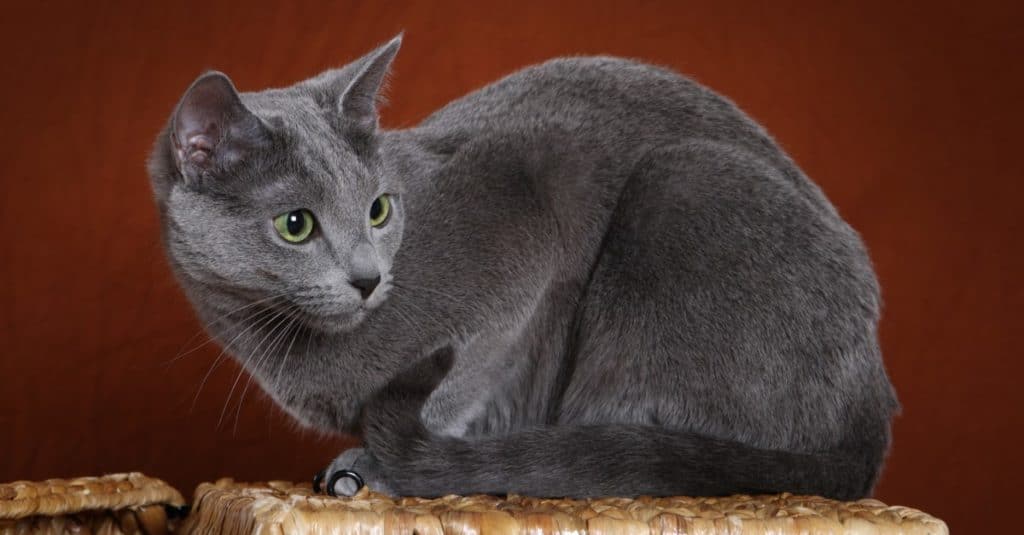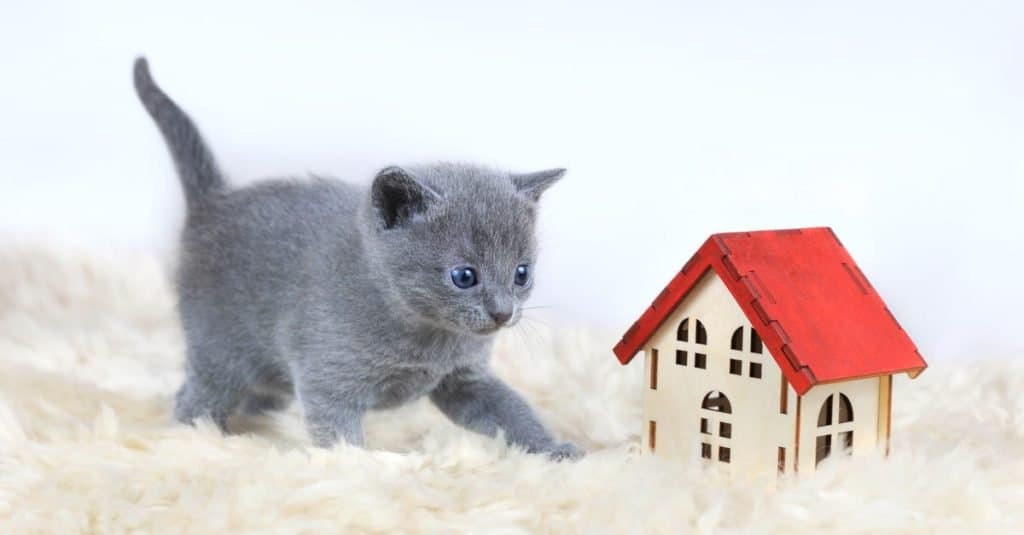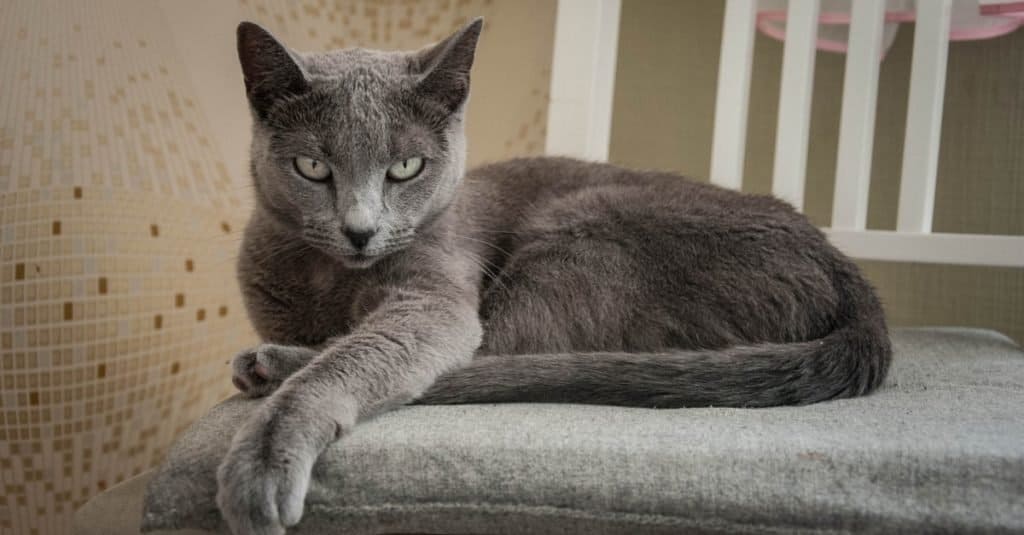With its short silvery-blue coat and bright green eyes, the Russian Blue is an elegant and striking cat breed popular not only in Russia but worldwide! If you’re lucky enough to own one of these handsome felines or are hoping to adopt one in the future, you’re likely wondering how big your Russian Blue cat will be when they reach their full size. Below, we’ll take an in-depth look at just how big they get, how quickly they grow, and even some interesting facts about the breed!
The Elegant Russian Blue Cat: History and Overview

True to its name, the Russian Blue’s homeland is the historic port city of Arkhangelsk, Russia.
©Bildagentur Zoonar GmbH/Shutterstock.com
Like many naturally-occurring cat breeds, it’s hard to pinpoint the Russian Blue cat’s exact origins and how it developed. However, most historians today believe the breed most likely originated in the port of Arkhangelsk, Russia.
Also known as the Archangel Isles, the port city is over 25 miles wide and includes several small islands. It lies along western Russia’s northern coast. Notably, the city was one of Russia’s most important port cities until the early 1700s when Saint Petersburg was developed.
Although much of the Russian Blue’s early history is uncertain, we do know how it spread from Russia to the rest of the world. Russian sailors took the cats with them from the Archangel Isles on voyages to the United Kingdom and parts of northern Europe in the 1860s. Soon, the cats began to spread throughout the European continent.
The first time the breed was acknowledged in Britain was in 1862, in a British newspaper called Leeds Mercury. At the time, the Russian Blue was known as the Archangel Cat. The breed was then further developed mainly in the UK and Scandinavia over the following few decades, until World War II, when its numbers declined and breeders began cross-breeding it with Siamese cats.
After the war, Russian Blues made their way to the United States, where the breed was refined, and much of its Siamese traits were bred out. This was when it truly became the cat it is known as today, with its short, dense blue-gray coat and striking green eyes. It remains a popular breed, being a mild-mannered, fairly low-maintenance option for first-time cat owners and experienced cat lovers alike.
How Big Are Russian Blue Kittens When They Are Born? What to Expect

Russian Blue kittens start their lives with blue eyes. As they age, however, their eyes gain their distinctive, emerald-green color.
©Mzorin/Shutterstock.com
Like most average-sized cat breeds, Russian Blue cats start as very small as kittens. At birth, a newborn Russian Blue cat is only about the size of the palm of your hand, or around 3 inches long. At birth, these elegant felines weigh just 80 to 100 grams on average, or around 3 to 4 ounces. For a bit more perspective, this is about the same size as a small apple or a baseball!
You might also be surprised to learn that Russian Blue kittens aren’t born with their trademark emerald green eyes. Like humans, all cats (regardless of the breed) are born with blue eyes. This is because their bodies don’t begin producing melanin until they are about six weeks old. Once melanin production begins, their eyes begin to slowly gain their vivid green pigmentation. By the time your Russian Blue is about six months old, its true eye color will likely be prominently visible!
Though they are tiny now, Russian Blue kittens grow fairly quickly, as we’ll cover in more detail below. By the end of the first month of their life, you can expect your baby Blue to weigh around a single pound.
How Quickly Do Russian Blue Cats Grow?

Although Russian Blue cats’ bodies grow at a typical rate, they can be slow to mature behaviorally. They often retain playful, kitten-like traits well into adulthood.
©palllna/Shutterstock.com
The Russian Blue is a healthy, hardy breed that grows at an average rate compared to most other cat breeds. You can generally expect your Russian Blue kitten to grow in size by around 0.5 to 1 pound each month until they are around 8 to 12 months old. However, they can continue putting on weight after their first year.
The exact point at which your Russian Blue cat reaches their adult size can vary by a few months. For some cats, they will be at their full adult size at one year of age. Others may grow more slowly, continuing to put on weight for a few extra months. However, virtually all Russian Blue cats stop growing by the time they are 16 to 18 months old at most.
Interestingly, although Russian Blues physically grow at a similar rate to most cats, they can be slow to mature behaviorally. Many cat owners note their Russian Blues have playful, kitten-like personalities that they often retain well into their adulthood.
As a highly athletic and agile breed, they enjoy having space to roam, play with toys, and explore, particularly during this key developmental stage. Despite this, though, they are otherwise rather quiet and reserved. It is normal for your Russian Blue to go through a mischievous stage during their first year, with most settling into a calmer, more easy-going temperament as adults.
How Big Do Russian Blue Cats Get? Average Sizes

Russian Blue cats are average-sized overall, but they have a slimmer, more athletic build compared to other breeds.
©ddisq/Shutterstock.com
Overall, the Russian Blue cat is average in size compared to other cat breeds. As a fully mature adult, your Blue should weigh between 7 and 15 pounds at most. They have a slightly slimmer build than most cats, though, with rather narrow bones and long, sinewy legs. Their bodies should ideally be lean yet muscular, elegant, and slim while still being strong and agile.
Thanks to their lean, athletic build and long legs, Russian Blues can often grow to be quite tall cats. Upon reaching their full size at 12 to 16 months old, they should ideally measure around 8 to 10 inches tall. However, particularly large males can be a bit taller.
Regardless of the breed, cats are sexually dimorphic, with males being heavier and sometimes also a bit taller than females on average. This means female Blues’ weights will be towards the lower end of the spectrum, or around 7 to 10 pounds. Males, meanwhile, usually weigh between 10 and 15 pounds, though this can vary.
Are Russian Blue Cats Bigger Than Other Cat Breeds?

An average Russian Blue cat can weigh twice as much as a Singapura cat, pictured here, which is one of the
smallest cat breeds
in the world. Overall, though, Russian Blues are average in size compared to most breeds.
©iStock.com/Viktor
As we touched on earlier, Russian Blue cats are a medium-sized breed overall. Compared to most other cat breeds, they are somewhere in the middle in size. However, they can appear slightly heavier than they are due to their thick, short coat, and their long, thin legs usually make them a bit taller.
Compared to the largest cat breeds such as the Maine Coon, which can weigh anywhere from 10 to 20 pounds on average, the Russian Blue is quite a bit smaller despite its extra-dense coat. An average Maine Coon can even be twice as heavy as a common Russian Blue!
But in comparison to breeds at the smaller end of the spectrum like the teeny-tiny Singapura, the Russian Blue is much heavier and taller. The average Russian Blue cat can be close to twice as heavy as a typical Singapura, which commonly weighs between just 4 and 8 pounds when fully grown. But overall, these sleek and elegant felines are pretty standard in overall size.
Russian Blue Cat Growth Chart
| Approximate Age | Approximate Weight |
| Newborn/0 Months | 80 to 100 grams (3 to 4 ounces) |
| 1 Month | 0.75 to 1 pound (12 to 16 ounces) |
| 2 Months | 1 to 2 pounds (16 to 32 ounces) |
| 3 Months | 2 to 3 pounds (32 to 48 ounces) |
| 4 Months | 3 to 4 pounds (48 to 64 ounces) |
| 5 Months | 4 to 5 pounds (64 to 80 ounces) |
| 6 Months | 5 to 6 pounds (80 to 96 ounces) |
| 7 Months | 5.5 to 6.5 pounds (88 to 104 ounces) |
| 8 Months | 6 to 7 pounds (96 to 112 ounces) |
| 9 Months | 6.5 to 8 pounds (104 to 128 ounces) |
| 10 to 12 Months | 7 to 10 pounds (112 to 160 ounces) |
| 12+ Months | 7 to 15 pounds (112 to 240 ounces) |
The photo featured at the top of this post is © Bildagentur Zoonar GmbH/Shutterstock.com
Thank you for reading! Have some feedback for us? Contact the AZ Animals editorial team.






